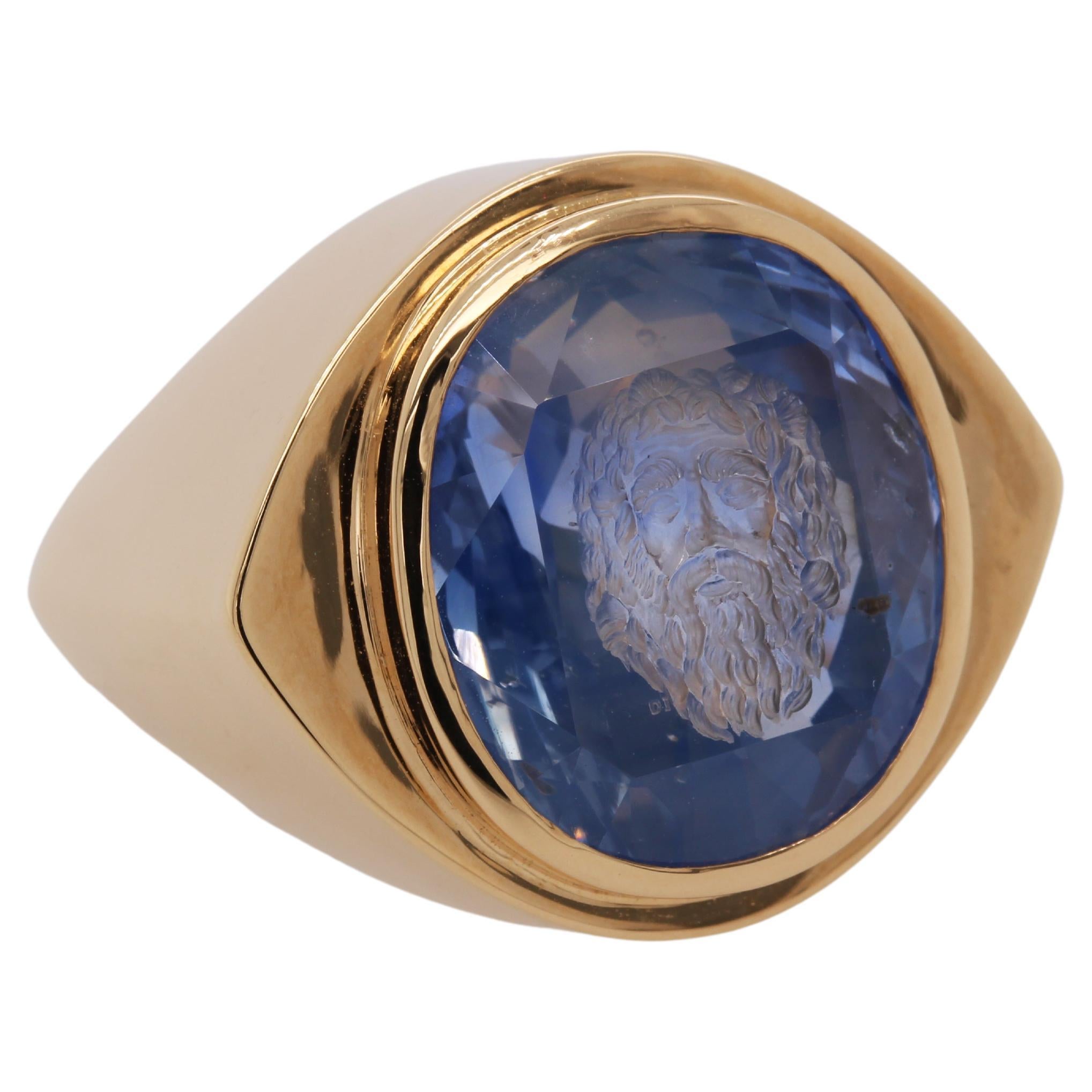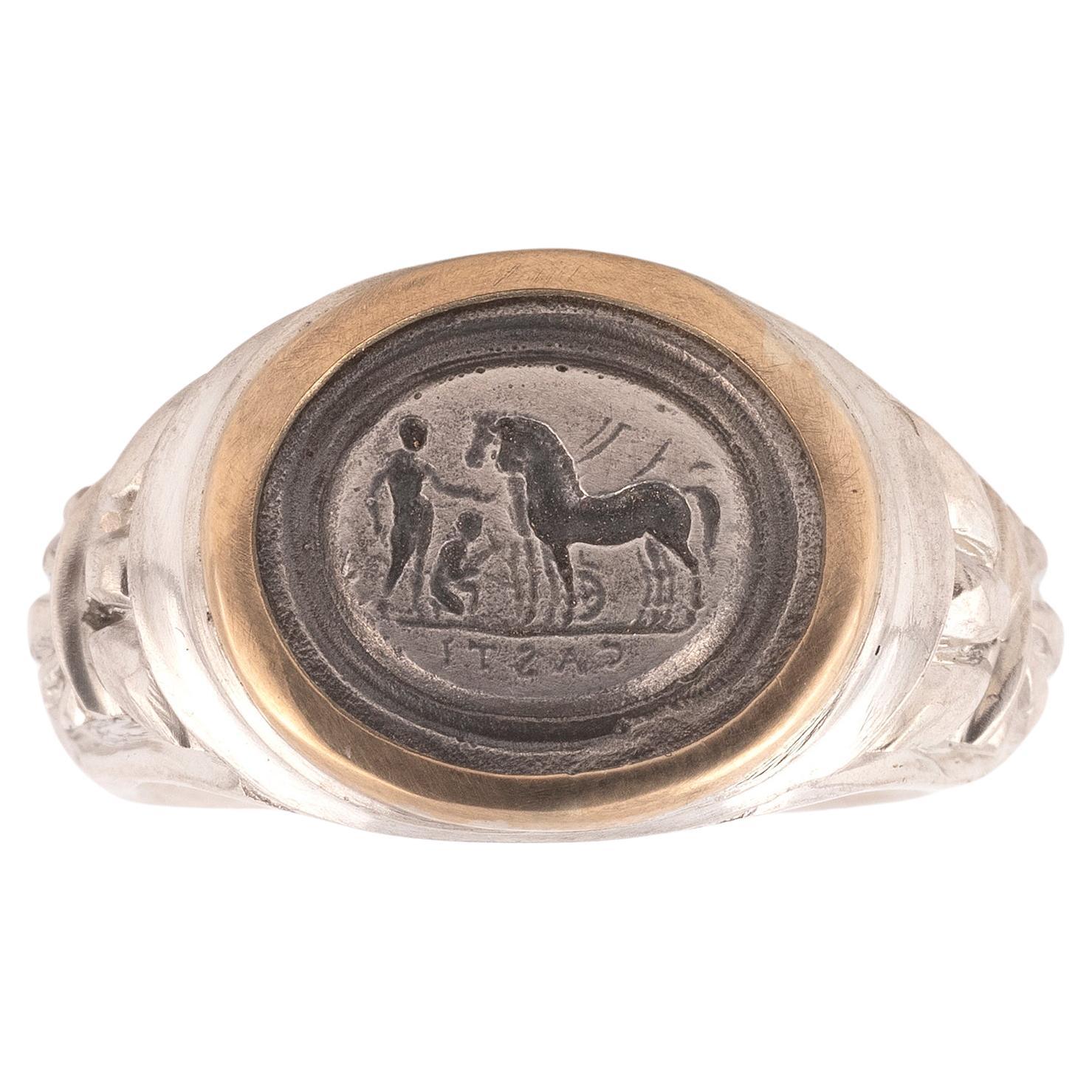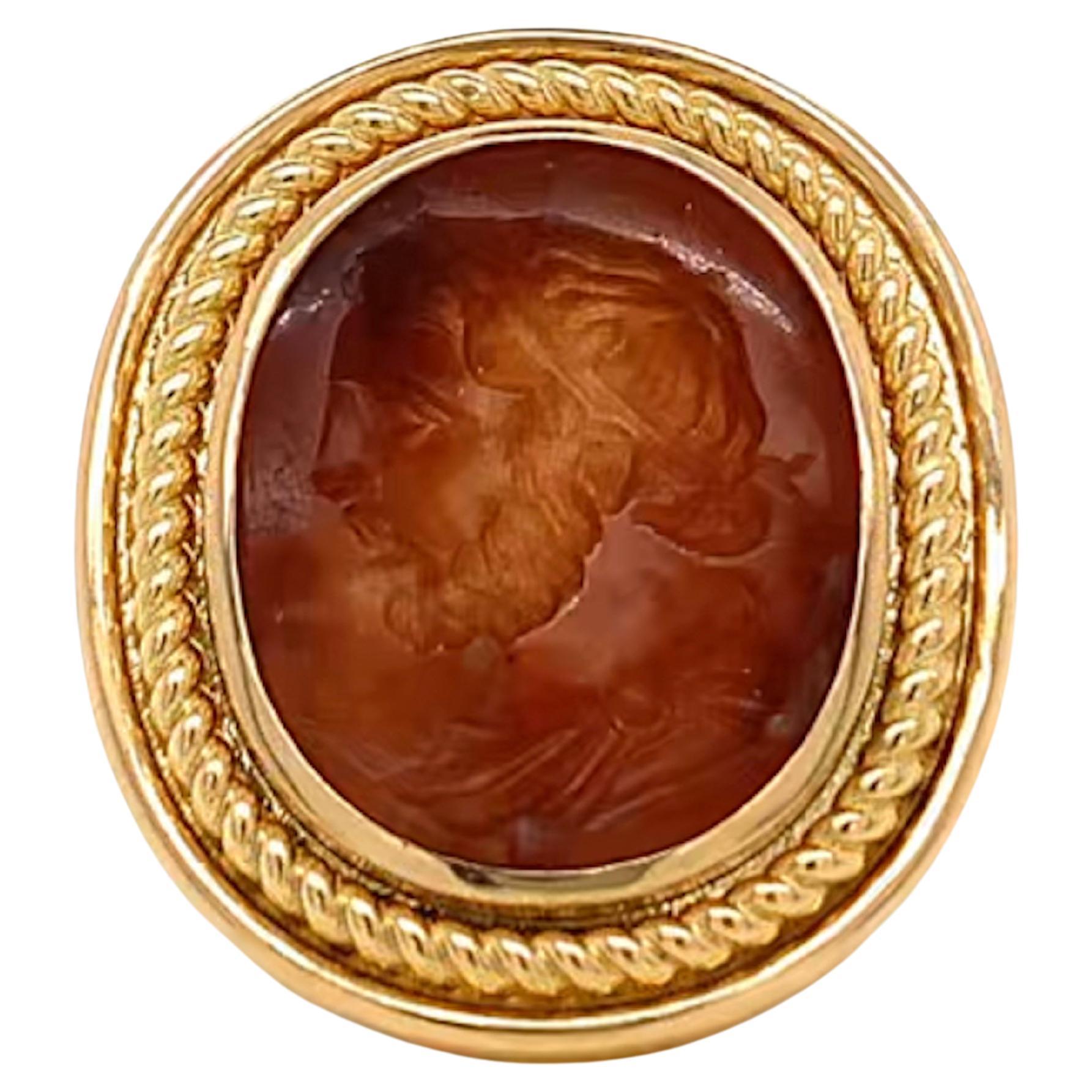Items Similar to Giovanni & Luigi Pichler 1790 Oval Intaglio Carved In Amber Mounted in 18Kt Ring
Want more images or videos?
Request additional images or videos from the seller
1 of 8
Giovanni & Luigi Pichler 1790 Oval Intaglio Carved In Amber Mounted in 18Kt Ring
About the Item
Important carved intaglio ring by Giovanni or Luigi Pichler (1773-1854).
Fabulous and extremely rare intaglio seal piece, created in Europe by the Pichler's Atelier in the late 18th century, circa 1790-1800. It was carved in an oval cabochon cut shape, from a single piece of natural translucent Amber of about 10 carats.
Mounted in an early 19th Century neo-classic ring crafted in solid 18 karats white gold. The flanks and borders of the ring's setting are decorated, with organics motifs characteristics from the period.
The seal depicts the profile of the naked portrait of the Roman goddess Venus, (Aphrodite) facing to the right, with a bow and decorations in the hair. Is signed at the lower left, Pichler in Greek (ΠΙΧΛΕΡ), for Giovanni or Luigi Pichler (1773-1854).
In Roman mythology, Venus was the goddess of love, sex, beauty, and fertility. She was the Roman counterpart to the Greek goddess Aphrodite. However, Roman Venus had many abilities beyond the Greek Aphrodite; she was a goddess of victory and fertility.
This ring Have a total weight of 7.1 Grams and the actual size is 5.25, sizeable. The top view measure are 21 mm by 25.6 mm (0.82 by 1.01 Inches).
Anton Pichler [Pikler] (Austria 1697-1779 Rome) Was the patriarch of the Pichler (ΠΙΧΛΕΡ) empire. He was an Austrian-German gemcutter who migrated to Naples, and then to Rome in 1743, where he was known as Antonio and gained great fame for the precision-beauty of his craft. Antonio trained his son Giovanni Pichler (1734-1791) as a worthy successor. Then in 1773 after he was past 75 Antonio fathered another son, Luigi-39 years the junior of Giovanni, his half-brother. Luigi Pichler was still a small child when Antonio died, but loyal Giovanni saw him raised as another worthy successor and accomplished artist. Luigi then carried forward the family business of classically-inspired luxury gem-cutting in Rome until his retirement in 1850, more than 100 years after his own father had founded the Pichler house.
Giovanni Pichler (Naples 1734-1791 Rome) was born in Naples Italy and trained by his father Antonio Pichler in the art of gem engraving in Rome. In 1769 he was appointed gem engraver to Emperor Joseph II in Vienna. Pichler's fame rapidly increased and he became a favorite of Grand Tourists. He also trained a number of the most famous engravers of the next generation including Filippo Rega and Antonio Berini. Upon his death in 1791 his workshop was inherited by his half brother Luigi Pichler. He went on to work for the Habsburg Imperial family in Vienna and so impressed the French court jeweler François-Régnault Nitot that the latter tried to persuade him to move to Paris. Luigi received many distinctions later in life including a diploma from the Academy of St Luke and membership of the Academy in Venice, as well as, in 1839, Knight's Cross of the Order of St Gregory the Great and, in 1842, of the Order of St Sylvester. He cut, after 15 years, a Hercules in Combat with the Nemean lions, a generally admired piece. His gems, both recessed and embossed, are of outstanding clarity and sharpness and he was one of the most sought-after engravers of his age, leaving him with a prolific 379 pieces to his name. He also worked in pastel painting. In 1790 he produced a catalogue of 200 examples of his work.
Luigi Pichler (Rome 1773-1854 Rome), was a member of the celebrated family of German-Italian gem engravers, studied under his father Anton Pichler and his elder half-brother Giovanni. Towards the end of the 18th century, he visited Austria where he attracted wide foreign patronage and in 1808 was presented to Emperor Francis I in Vienna. In 1818 he was appointed Professor of Gem Engraving at Akademie der Bildenden Künste in Vienna, a post he held until 1850 before retiring to Rome. He was known for his contemporary portraits and "his preferred medium was intaglio distinguished by exquisite polish and often executed in gemstones rather than the more usual hardstones" (Grove Dictionary of Art). Like all members of his family and according to common practice of the day, he signed his work in various ways, including his name, last name (ΠΙΧΛΕΡ) and initials in Greek and Roman letters. He turned back to Rome in 1850, where he died in 1854.
About the signature of this piece, we are citing as a reference, a text from the catalogue of the Hull Grundy Gift (Gere et al 1984) no 834: This form of signature was used by both Giovanni and his half-brother Luigi. The style of the intaglio suggests a late eighteenth-century date, and an attribution to a late work by Giovanni, is consistent with other gems from his hand, but Luigi was taught by his half-brother and took over his unfinished work in 1791. Dalton says of Giovanni: “.... they can be very much alike ... when ... Luigi Pichler copied one of Giovanni's gems and signed in the same way as his brother, it is difficult to be sure which of the two was actually the artist.” Rollett (1874) lists only two intaglios of this subject, both as by Giovanni (no's 54 & 55), so it seems safe to assume that this gem was cut by him. An account of Giovanni's life was published in Rome the year after his death (see de Rossi 1792). (Charlotte Gere).
Chronology of the Pichler's signatures:
Giovanni Pichler (1734-1791) ΠΙΧΛΕΡ
Luigi Pichler (1773-1854) Λ.ΠΙΧΛΕΡ (note the addition of the L in Greek).
Literature: Dr. Hermann. Rollett, “Die Drei Meister der Gemmoglyptc, Antonio, Giovanni und Luigi Pichler”, Vienna, W. Braumüller 1874, page 65, No 133. for an almost identical piece. Duffield Osbourne “Engraved Gems” H. Holt & company,1912 Plate XXXI number 4, for similar examples.
Related Bibliography: Dr. Hermann. Rollett, “Die Drei Meister der Gemmoglyptik: Antonio, Giovanni and Luigi Pichler” Vienna, W. Braumüller, 1874. For his biography. R. Distelberger, “Luigi Pichler' in 'Österrechisches Biographisches Lexikon”, Vol 36, Vienna 1979. For similar pieces. L. Forrer, "Biographical Dictionary of Medallists", Volume VIII, Spinks & Son, London 1930, Pp-126-127. For Inventories. Gabriella Tassinari, “Lettere di una celebre famiglia di incisori di pietre dure : i pichler”. article 2005. Gabriela Tassinari, "I ritratti dei viaggiatori del Grand Tour sugli intaglio ed i cammei di Giovanni Pichler", in Bollettino del Centro Interuniversitario di ricerche sul viaggio in Italia; 26:1 (2005), Pp. 11-79. Lippold, Gemmen und Kameen des Altertums und der Neuzeit, Stuttgart, 1922, pl. CXXVII, no. 7; B. Baumgärtel,Angelica Kaufmann (1741-1807), exh. cat. Kunstmuseum, Dusseldorf; Haus der Kunst, Munich; Bündner Kunstmuseum, Chur, 1998, pp. 338-9. L. Bignamini, C. Hornsby, Digging And Dealing In Eighteenth-Century Rome (2010), Pp 316-317. Seidmann, "The Grand Tourist's favourite souvenirs: cameos and intaglios", in RSA Journal (1996), Pp. 63-66. Catalogo di impronti cavati da gemme incise dal Cavaliere Giovanni Pichler ... (1790).
Collections: The British Museum, London, UK. The Victoria & Albert Museum, London UK. The Corning Museum of Glass, New York, NY. The Walters Art Museum, Baltimore, MD. The Hermitage Museum, St Petersburg Russia. The Metropolitan Museum of Art, New York, USA.
Note: The plaster cast impression of this gem engraving can be found in, Duffield Osbourne, “Engraved Gems”, H. Holt and company,1912 Plate XXXI number 4.
Note: The carving of this piece in natural Amber, it is a great discovery of the work done by the Pichler family, this is the only known piece carved in this material. It should be noted that Amber is a very difficult one to work in low reliefs due to the fragility of the material.
Note: An engraved gem, frequently referred to as an intaglio, is a small and usually semi-precious gemstones that has been carved, in the western tradition normally with images or inscriptions only on one face. The engraving of gemstones was a major luxury art form in the ancient world, and an important one in some later periods.
This is an extremely rare piece, it is in great condition and the intaglio carving are perfect.
INVENTORY REF: R0000CNNB/.1682
- Creator:Luigi Pichler
- Ring Size:5.25 US, Resizable
- Metal:
- Stone:Amber
- Stone Cut:
- Weight:7.15 g
- Style:
- Place of Origin:
- Period:1790-1799
- Date of Manufacture:1790
- Condition:Wear consistent with age and use. An extremely rare piece in excellent condition.
- Seller Location:Miami, FL
- Reference Number:
Resizing is available.
May be sized on requestAbout the Seller
4.9
Recognized Seller
These prestigious sellers are industry leaders and represent the highest echelon for item quality and design.
Platinum Seller
These expertly vetted sellers are 1stDibs' most experienced sellers and are rated highest by our customers.
Established in 1995
1stDibs seller since 2022
416 sales on 1stDibs
Typical response time: <1 hour
- ShippingRetrieving quote...Ships From: Miami, FL
- Return PolicyA return for this item may be initiated within 1 day of delivery. Please be advised, certain types of customizations are not eligible for returns.
More From This SellerView All
- Giovanni & Luigi Pichler 1790 Rare Agate Carved Intaglio of Mercury in 14kt GoldLocated in Miami, FLImportant carved intaglio ring by Giovanni or Luigi Pichler (1773-1854). An extremely rare intaglio seal piece, created in Rome Italy by the Pichler's Atelier in the late early 18th century, circa 1795. It was carved in an oval cabochon cut shape, from a triple layered translucent bluish agate. The intaglio seal depicts the naked figure of the Roman goddess Mercury, in running flying position to the right with a helmet and winged sandals. Raising his left hand and holding a trophy with the right hand. A butterfly or flying insect at the right. Signed, Pichler in Greek (ΠΙΧΛΕΡ), for Giovanni or Luigi Pichler (1773-1854). This seal has been made after the famous Flying Mercury (Mercure volant) statue, created by the mannerist sculptor Giambologna (Giovanni da Bologna 1524-1608), a Flemish-Italian sculptor that work all his life mostly in Florence in Italy. One of the versions of the actual sculpture is located at the Bargello Museum in Florence Italy and the other at the Louvre Museum in Paris. Mercury. in Latin Mercurius, in Roman religion is the god of shopkeepers and merchants, travelers and transporters of goods, and thieves and tricksters. He is commonly identified with the Greek Hermes...Category
Antique Early 18th Century Italian Classical Roman Signet Rings
MaterialsAgate, Fire Agate, Gold, 14k Gold, White Gold
- Etruscan Intaglio Signet Cocktail Ring With Carved Carnelian In 18Kt Yellow GoldLocated in Miami, FLSignet ring with carnelian. Gorgeous statement signet ring, crafted in Europe in solid yellow gold of 18 karats with high polished finish. Designed in the ancient style with very bo...Category
Vintage 1980s Italian Etruscan Revival Cocktail Rings
MaterialsCarnelian, Gold, 18k Gold, Yellow Gold
- Ancient Seal Ring In Hammered 18Kt Yellow Gold With Carved Carnelian IntaglioLocated in Miami, FLAncient Seal ring with Carnelian Intaglio. Beautiful medieval revival piece, crafted in solid yellow gold of 18 karats with hammered finish. It is mount on top in a bezel, with one oval (27 x 22 x 4 mm) ancient Arabic...Category
Antique 19th Century English Medieval Cocktail Rings
MaterialsCarnelian, Gold, 18k Gold, Yellow Gold
- Dinh Van 1970 Paris Geometric Sculptural Ring In 18Kt White Gold With LapisBy Jean Dinh VanLocated in Miami, FLSculptural ring designed by Jean Dinh Van. An iconic geometric ring, created in Paris France by the artist goldsmith Jean Dinh Van, back in the 1970. This ring has been crafted with pure forms in solid white gold of 18 karats with high polished finish. Embellished with a natural vivid blue Afghani lapis lazuli. This piece blends perfectly with the geometric motif so dear to the Maison of Dinh Van. and Cartier back in the 1970. This same model was also produced for Cartier. Lapis Lazuli: Mount on top in a bezel setting, with 1 oval cabochon cut (12 x 14 x 3 mm) carved from natural blue lapis lazuli of about 5 carats. Weight: 6.3 Grams, (4.15 Dwt.). Size: 5 and may be sized on request. Measures: 17 mm by 16 mm (0.67 x 0.63 Inches) and raise 7 mm over the finger. Hallmarks: Stamped with French marks; the maker's Maitre cartouche Ste DD (Societe Dinh Van), the gold assay mark and signed in full, "1970 DINH VAN© 18 KT". Dinh Van - Editorial Article – Broken English Jewelry...Category
Vintage 1970s French Modernist Signet Rings
MaterialsLapis Lazuli, Gold, 18k Gold, White Gold
- Seaman Schepps 1950 New York Very Rare 18Kt Gold Wired Ring Carved in AmberBy Seaman ScheppsLocated in Miami, FLRare vintage ring designed by Seaman Schepps. A modernist piece from the late American art deco period. Has been created in New York city, circa 195...Category
Vintage 1950s American Modernist Cocktail Rings
MaterialsAmber, Gold, 18k Gold, Yellow Gold
- Greek Sicily 461 BC Segesta Ancient Coin Flip Signet Ring in 18kt Yellow GoldLocated in Miami, FLSignet flip ring with an ancient coin from Segesta city. Fabulous coin signet ring, crafted with ancient flip technique in solid yellow gold of 18 ka...Category
Antique 15th Century and Earlier Italian Classical Greek Signet Rings
MaterialsGold, 18k Gold, Yellow Gold, Silver
You May Also Like
- A Gold Ring With Carnelian Intaglio By Giovanni Pichler Circa 1780Located in Firenze, ITA finger ring with a cornelian intaglio depicting a scene of sacrifice to Priapus. Size: 7 Weight: 13gr.Category
Antique 1780s Italian Signet Rings
MaterialsCarnelian, Gold, 18k Gold
- Castellani GIA 20.64ct Sapphire Hand Carved Intaglio 18kt RingBy CastellaniLocated in New York, NYCastellani® commissioned to have this 20.64ct sapphire be hand carved as an intaglio of the mythical character Neptune /Poseidon. Neptune was to the Ancient Romans the god that controlled the waters, winds and storms. The Ancient Greeks called him Poseidon. The hand carving shows the subject’s face, hair and eyes in very great detail. This large natural sapphire is Sri Lanka origin and No Heat, devoid of any enhancement. All gemological information is on a GIA Gemological Report. The GIA classifies the shape as an Oval Intaglio. The cornflower blue color and the sapphire’s crystal transparency lets the carving be seen easily and is very noticeable. Bezel set into the “Cleopatra” ring...Category
21st Century and Contemporary American Etruscan Revival Signet Rings
MaterialsSapphire, 18k Gold
- 18kt Yellow Gold And Silver Intaglio Horses Men's RingLocated in Firenze, ITDepicting two figures attending to horses. Top size lenght 18mm Size 9 Weight : 20,47gr.Category
Antique Late 19th Century Italian Signet Rings
MaterialsYellow Gold, Silver
- 18kt Yellow Gold And Silver Intaglio Cupid Men's RingLocated in Firenze, ITDepicting Cupid riding a seahorse Top Lenght size 23mm Size 9 Weight : 34,19gr.Category
Antique Late 19th Century Italian Signet Rings
MaterialsYellow Gold, Silver
- Castellani Ancient 7th Century Carnelian Intaglio 18kt Gold RingBy CastellaniLocated in New York, NYThe 7th century Roman intaglio is set into the Castellani® Artemis designed ring. The intaglio is set under the bezel, as jewellers did intaglio and cameo rings 2000 years ago. The g...Category
21st Century and Contemporary American Etruscan Revival Signet Rings
MaterialsCarnelian, Gold, 18k Gold
- 18KT Yellow Gold Oval Cabochon Jade Signet RingLocated in Los Angeles, CAThis estate oval cabochon jade signet ring is crafted in 18KT yellow gold and dates from the 1970’s. It features a striking bezel set oval green jade that measures approximately 16mm...Category
Vintage 1970s Contemporary Signet Rings
MaterialsJade, Yellow Gold
Recently Viewed
View AllMore Ways To Browse
Antique Life Rings
Antique Jewelry York
Antique Jewellery York
Antique Jewelry New York
Antique Jewellery New York
Important Early Ring
19th Century Italian Ring
Antique German Rings
Antique German Ring
Russian Antique Rings
Russian Antique Ring
Antique Russian Ring
Antique Russian Rings
Intaglio Ring Antique
Antique Intaglio Rings
Italian Hardstone
Carved Signet Rings
Carved Signet Ring





